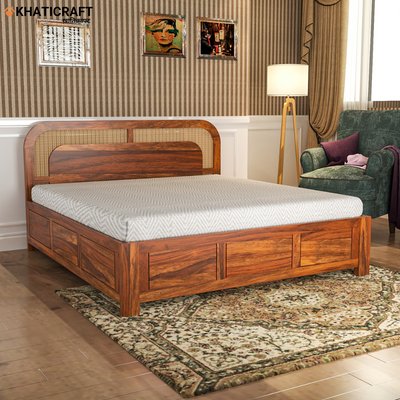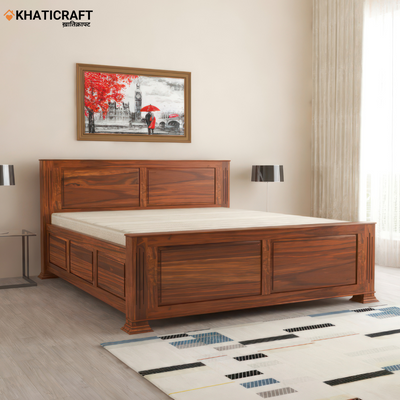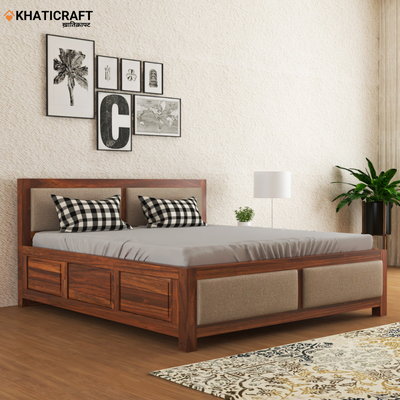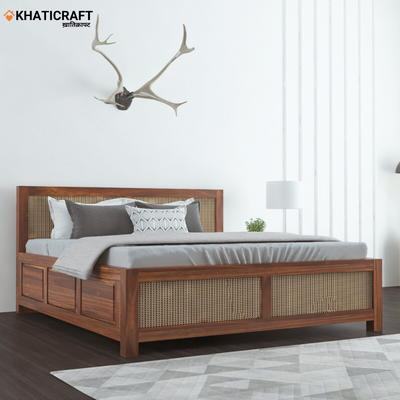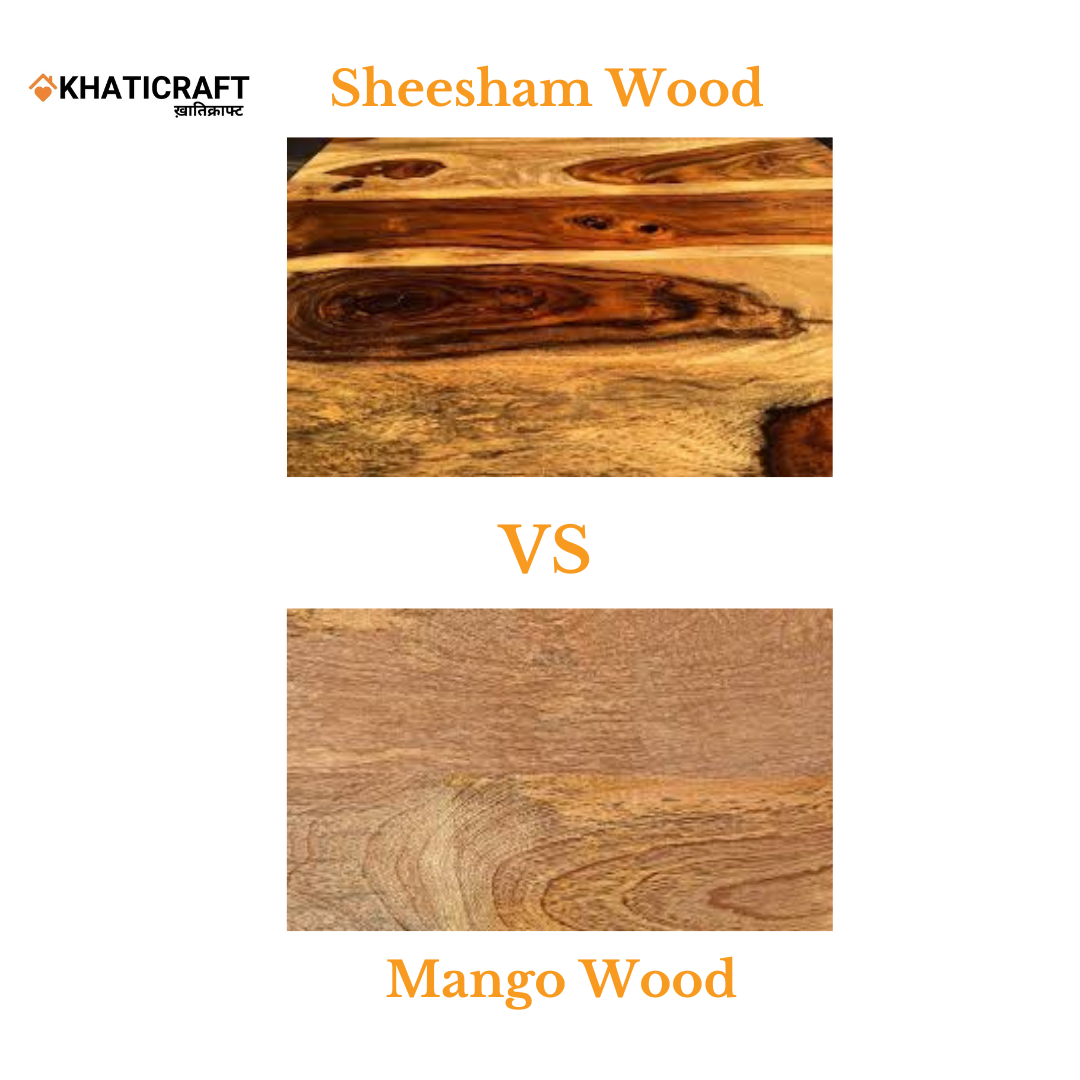Solid Sheesham Wood vs. Mango Wood: A Comparative Analysis for Furniture
When it comes to crafting exquisite furniture pieces, the choice of wood is an important decision. Two of the most common types of wood for furniture used include solid Sheesham wood and mango wood. Each of these materials possesses unique characteristics that can greatly impact the aesthetics, durability, and overall quality of your furniture.
In this blog, we'll talk about the key aspects of both solid Sheesham and mango wood and Mango wood vs sheesham wood to help you make an informed decision.
Sheesham Wood

Sheesham wood, which is also called Indian Rosewood, is the best type of wood furniture obtained from the Sheesham tree. This tree species is native to the Indian subcontinent, particularly prevalent in countries like India, Pakistan, Nepal, and Bangladesh. Sheesham wood is highly valued for its exceptional strength, distinctive grain patterns, and rich color, making it a popular choice for furniture crafting, decorative items, and various woodworking projects.
Sheesham Wood Pros
Durability and Strength: Sheesham wood is known for its exceptional durability and strength, making it a reliable choice for long-lasting furniture pieces.
Distinctive Grain Patterns: The wood's prominent and elegant grain patterns add visual interest and enhance the overall aesthetics of furniture.
Elegant Appearance: Sheesham wood's rich, dark brown color lends an air of sophistication and elegance to furniture, making it suitable for both traditional and contemporary designs.
Carving and Detailing: Its workability allows for intricate carving and detailing, enabling craftsmen to create intricate designs and decorative elements.
Resistance to Decay and Insects: Sheesham solid wood furniture’ natural resistance to decay and insects makes it suitable for furniture that will be exposed to various environmental conditions.
Longevity: When properly cared for, online solid wood furniture made from Sheesham wood can last for generations, maintaining its beauty and structural integrity.
Sheesham Wood Cons
Cost: Solid Sheesham wood is mostly considered a premium hardwood, which can lead to higher costs compared to some other wood types.
Maintenance: Sheesham wood needs regular maintenance, including polishing and sealing, to preserve its appearance and prevent moisture-related issues.
Sourcing: Based on the region, sourcing sustainably harvested Sheesham wood might be a consideration to ensure ethical and environmentally friendly practices.
Weight: The density of Sheesham wood can make furniture pieces quite heavy, which might be a consideration for certain applications.
Color Variation: While the variation in color can add character, some pieces of Sheesham wood might have more pronounced variations, which could affect the uniformity of larger furniture items.
Hardness for DIY: While it's workable for skilled craftsmen, its density and hardness might pose challenges for DIY enthusiasts with limited woodworking experience. Thus it is suggested to buy this kid of wood furniture from the experts only.
Buying solid wood furniture from leading manufacturers like khaticraft helps get the best utility furniture with no or very less cons.
Mango Wood

Mango wood is obtained from the mango tree (Mangifera indica), which is primarily cultivated for its delicious fruit. When mango trees reach the end of their fruit-bearing life or are pruned to promote new growth, the wood is harvested as a byproduct. Mango wood has wider popularity in the world of furniture crafting due to its unique characteristics and sustainable sourcing.
Pros of Mango Wood
Aesthetic Variety: Mango wood showcases a diverse range of colors, spanning from light tan to medium brown. Its natural variations contribute to its visual appeal.
Distinctive Grain Patterns: One of the standout features of mango wood is its grain patterns. Swirls, curls, and interlocking lines create unique and captivating designs on furniture surfaces.
Affordability: Compared to some other hardwoods, mango wood is often more affordable, making it an attractive option for those seeking quality within a budget.
Sustainability: Mango wood is considered environmentally friendly due to its sourcing from trees that have reached the end of their fruit-bearing life or during pruning, thereby utilizing existing resources.
Ease of Workability: Mango wood is relatively easy to work with, making it suitable for both handcrafted and mass-produced furniture. This workability allows for various design possibilities.
Natural Beauty: The wood's natural color and grain patterns require minimal alteration, enhancing the appeal of furniture made from mango wood.
Cons of Mango Wood
Durability: While mango wood is durable, it may not be as hard as some other hardwoods. Proper sealing and finishing are essential to enhance its resistance to wear and tear.
Maintenance: Like other wood types, mango wood requires proper maintenance, including sealing and finishing, to protect against moisture, scratches, and other potential damage.
Color Variation: The color variation in mango wood might not suit every design aesthetic. Some pieces may have more pronounced color differences, affecting the uniformity of larger furniture items.
Limited Supply: Mango wood availability is tied to the cultivation of mango trees for their fruit. As such, it might not be as widely available as some other types of wood.
Weight: Similar to other hardwoods, mango wood's density can make furniture pieces relatively heavy, which might be a consideration for specific applications.
Longevity: While mango wood is durable, its longevity might not match that of some more robust hardwoods like Sheesham in the long run.
Detailed Comparison Between Solid Sheesham Wood and Mango Wood
Origin and Availability
Solid Sheesham wood, also known as Indian Rosewood, is sourced from the Sheesham tree (Dalbergia sissoo), primarily found in the Indian subcontinent. Its availability is closely tied to regions where these trees are cultivated.
On the other hand, mango wood is derived from the mango tree (Mangifera indica), commonly grown for its delicious fruit. Mango wood often comes from trees that have reached the end of their fruit-bearing life or are pruned to promote new growth, making it a byproduct of mango cultivation.
Appearance and Grain
Solid Sheesham wood boasts a rich, dark brown color with pronounced grain patterns that lend an air of elegance to furniture pieces. Occasionally, lighter streaks or variations in color may appear, adding to its visual intrigue.
Mango wood, in contrast, spans a spectrum of hues from light tan to medium brown. Its distinctive grain patterns, characterized by swirls and interlocking lines, set it apart and contribute to a more rustic or contemporary aesthetic.
Durability and Strength
In terms of durability, solid Sheesham wood reigns supreme. It is highly revered for its exceptional strength and ability to resist decay and insects, factors that make it well-suited for crafting enduring furniture.
Mango wood also possesses a degree of durability, although it is not as hard as some other hardwoods. To maximize its longevity, proper sealing and finishing are essential.
Workability and Craftsmanship
Both woods offer favourable workability, each with its own advantages. Solid Sheesham wood's relative ease of manipulation makes it suitable for intricate carving and detailing, enabling skilled craftsmen to create intricate designs.
Mango wood, with its general ease of working, caters to both handcrafted and mass-produced furniture, allowing for versatile designs that accommodate a range of styles.
Aesthetic Appeal
The choice between Sheesham and mango wood significantly influences the aesthetics of your furniture. Solid Sheesham wood lends a classic and timeless allure with its deep, rich color, rendering it appropriate for both traditional and contemporary designs.
Mango wood, with its lighter shades and captivating grain patterns, imparts a rustic or modern feel, ideal for those seeking a more casual and natural ambiance.
Sustainability
Mango wood holds an advantage in sustainability due to its sourcing practices. It often comes from trees at the end of their fruit-bearing life or during pruning. This utilization of existing resources makes mango wood a more environmentally conscious choice. Solid Sheesham wood, while sourced from cultivated trees, can be deemed sustainable when harvested from responsibly managed forests.
Maintenance
Both woods require proper care to preserve their integrity and aesthetics over time. Solid Sheesham wood demands regular maintenance, including polishing and sealing, to maintain its luster and durability.
Similarly, mango wood benefits from proper sealing and finishing to safeguard against moisture and wear, ensuring a long-lasting and attractive piece of furniture.
Cost Considerations
The cost aspect is a noteworthy factor in choosing between these woods. Solid Sheesham wood, often regarded as a premium hardwood, can command a higher price due to its luxurious appearance and durability. Conversely, mango wood tends to be more affordable, making it an attractive option for those seeking quality within a budget.
Conclusion
In the end, the final decision between solid Sheesham wood and mango wood and how to check quality of wood depends on various factors, including the desired aesthetics, durability, and design preferences.
Sheesham wood offers a rich and elegant appearance along with exceptional strength, making it a popular choice for classic and contemporary designs. Mango wood's diverse grain patterns and sustainability factor make it a versatile option that suits both rustic and modern aesthetics.
If you look for a long term investment, then sheesham wood furniture is an ideal option. Considering your specific requirements and preferences, you can get the best kind of furniture designed by the experts at Khaticraft, an online solid wood furniture store.
FAQ's
1. Explain Mango wood vs sheesham wood?
Regarding Mango wood vs sheesham, solid Sheesham Wood is obtained from the Sheesham tree and is known for its dark color and elegant grain patterns. Mango Wood, on the other hand, is obtained from the mango tree and offers a variety of colors and unique grain patterns.
2. Which wood is more durable, Sheesham or Mango?
Solid Sheesham Wood is considered more durable due to its exceptional strength and natural resistance to decay and insects. Mango Wood is also durable but may require proper sealing and finishing for enhanced longevity.
3. Can you describe the aesthetic differences between the two woods?
Sheesham Wood has a rich, dark brown color with distinct grain patterns, while Mango Wood ranges from light tan to medium brown with eye-catching swirls and interlocking lines in its grain.
4. Which solid wood furniture is easier to work with for crafting intricate designs?
Solid Sheesham Wood is relatively easy to work with and is suitable for intricate carving and detailing. Mango Wood is also easy to work with, making it versatile for both handcrafted and mass-produced furniture.
5. Are these woods environmentally friendly?
Mango Wood is considered more environmentally friendly since it often comes from trees at the end of their fruit-bearing life or during pruning. Sheesham Wood's sustainability depends on responsible sourcing and forest management practices.
6. Which wood is better for traditional designs, and which is better for contemporary designs?
Solid Sheesham Wood is well-suited for both traditional and contemporary designs due to its rich color and elegant appearance. Mango Wood's lighter shades and diverse grain patterns make it suitable for contemporary and rustic designs.
7. Is one wood more expensive than the other?
Solid Sheesham Wood is often considered a premium hardwood and may be more expensive compared to Mango Wood, which tends to be more affordable.
8. How do maintenance requirements differ between Sheesham and Mango Wood?
Both woods require regular maintenance, including sealing and finishing, to protect against moisture and wear. Sheesham Wood may need more frequent maintenance due to its darker color.
